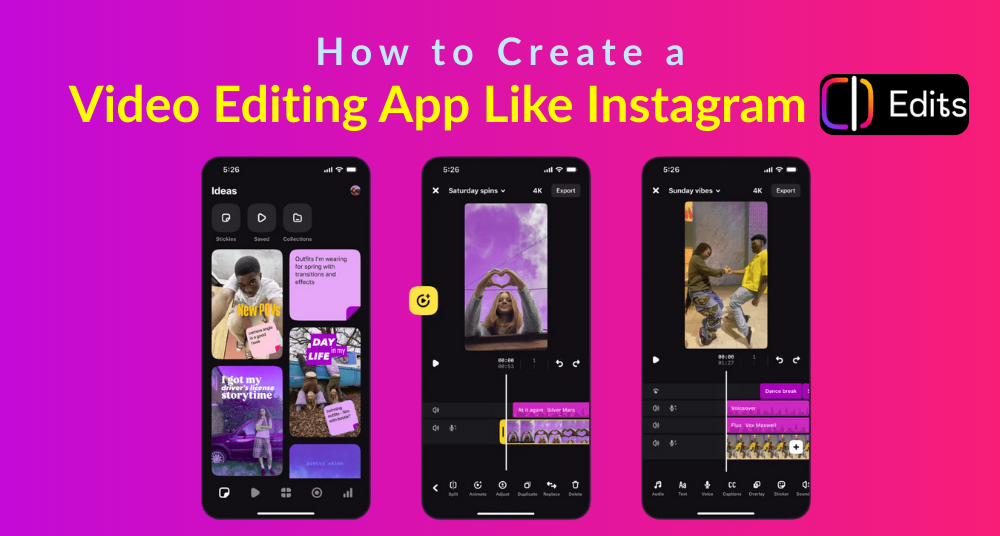In April 2025, Meta launched Edits, a standalone video editing app designed to rival TikTok’s CapCut. With features like AI-generated animations, green screen capabilities, and high-resolution exports, Edits has set a new standard for mobile video editing. This launch is particularly significant in India, where mobile video content creation is booming. If you’re considering developing a Video Editing App Like Instagram Edits, this guide will walk you through the essential steps, from ideation to launch.
Step 1: Define Your Vision and Target Audience
Before diving into development, it’s crucial to understand the purpose of your app and who will use it. Ask yourself:
- Who is your target audience? Are they content creators, casual users, or businesses?
- What unique value will your app offer? Consider features like AI-powered editing, real-time collaboration, or advanced visual effects.
- How will your app stand out? Research competitors like CapCut, Canva, and Instagram Edits to identify gaps and opportunities.
Understanding these aspects will help you create a focused and user-centric app.
Step 2: Plan Core Features and Functionalities
Based on your vision, outline the core features of your app. Essential functionalities might include:
- Video Editing Tools: Trim, cut, merge, and adjust video speed.
- Audio Editing: Add music, voiceovers, and sound effects.
- Filters and Effects: Offer a variety of visual enhancements.
- Text and Stickers: Allow users to add captions and graphics.
- Export Options: Provide high-resolution exports without watermarks.
- AI Features: Implement tools like background removal or scene detection.
Ensure these features align with your target audience’s needs and preferences.
Step 3: Choose the Right Technology Stack
Selecting the appropriate technology stack is vital for the performance and scalability of your app. Consider the following:
- Frontend Development: Use frameworks like React Native or Flutter for cross-platform compatibility.
- Backend Development: Node.js or Python with Django can handle server-side operations.
- Video Processing: Utilize libraries such as FFmpeg or Android’s Media3 Transformer for efficient video editing.
- AI Integration: Leverage machine learning frameworks like TensorFlow Lite for on-device AI processing.
Ensure your chosen technologies support the features you plan to implement.
Step 4: Design an Intuitive User Interface
A user-friendly interface is key to the success of any app. Focus on:
- Simplicity: Keep the design clean and easy to navigate.
- Responsiveness: Ensure the app performs well on various devices.
- Accessibility: Make the app usable for people with disabilities.
- Branding: Incorporate consistent colors, fonts, and logos to build brand identity.
Consider conducting user testing to gather feedback and make necessary adjustments.
Step 5: Develop and Integrate Features
Begin the development process by:
- Setting Up the Development Environment: Configure your chosen frameworks and tools.
- Implementing Core Features: Start with basic functionalities like video trimming and audio addition.
- Integrating Advanced Features: Gradually add complex features such as AI effects and real-time collaboration.
- Testing: Continuously test the app to identify and fix bugs.
Adopt an agile development approach to allow for flexibility and iterative improvements.
Step 6: Test and Refine
Thorough testing is essential to ensure the app’s reliability and performance:
- Functional Testing: Verify that all features work as intended.
- Performance Testing: Assess the app’s speed and responsiveness.
- Usability Testing: Ensure the app is easy to use and navigate.
- Security Testing: Protect user data and privacy.
Gather feedback from beta testers and make necessary refinements before launch.
Step 7: Launch and Market Your App
Once the app is ready, plan your launch strategy:
- App Store Optimization (ASO): Optimize your app’s listing with relevant keywords and appealing visuals.
- Marketing Campaigns: Utilize social media, influencers, and online ads to promote your app.
- User Support: Provide clear instructions and responsive customer service to assist users.
Monitor user feedback and app performance to make continuous improvements.
Step 8: Monetization Strategies
To generate revenue from your app, consider the following monetization options:
- Freemium Model: Offer basic features for free and charge for premium functionalities.
- In-App Purchases: Sell additional features or content within the app.
- Subscriptions: Provide ongoing access to premium features for a recurring fee.
- Advertisements: Display ads within the app to earn revenue.
Choose a model that aligns with your app’s value proposition and user expectations.
Estimated Development Costs
Developing a video editing app can be a significant investment. Costs vary based on complexity and features:
- Basic App: $15,000 – $30,000
- Advanced App: $30,000 – $250,000+
Factors influencing cost include:
- Feature Set: More complex features increase development time and cost.
- Platform: Developing for multiple platforms (iOS and Android) adds to the expense.
- Development Team: Rates vary by location and expertise.
It’s essential to budget accordingly and plan for ongoing maintenance and updates.
Future Trends in Video Editing Apps
The video editing app landscape is continually evolving. Stay ahead by considering emerging trends:
- AI Integration: Enhance editing capabilities with artificial intelligence.
- Cloud Collaboration: Allow multiple users to edit videos simultaneously.
- Augmented Reality (AR): Incorporate AR effects and filters.
- Voice Control: Enable hands-free editing through voice commands.
By staying informed and adaptable, you can ensure your app remains competitive and relevant.
Conclusion
Developing a video editing app like Instagram Edits involves careful planning, execution, and ongoing improvement. By focusing on user needs, leveraging the right technologies, and staying attuned to industry trends, you can create an app that stands out in the crowded market. Remember, the key to success lies in delivering value to your users and continuously evolving to meet their expectations.
Latest Industry Insights
- Instagram Edits Launch: Instagram’s new video editing app, Edits, offers advanced features like AI-generated animations and green screen capabilities, aiming to compete with TikTok’s CapCut The Verge.
- Market Growth: The video editing app market is projected to reach $3.1 billion by 2030, highlighting the growing demand for mobile video editing solutions.
Frequently Asked Questions (FAQs)
1. What is a video editing app like Instagram Edits?
A video editing app like Instagram Edits is a mobile application that allows users to create, edit, and enhance videos with tools like trimming, filters, effects, text, and audio integration. It also often includes AI-powered features like automatic animations and background removal.
2. When was Instagram Edits launched in India?
Instagram Edits was launched in India in April 2025, bringing advanced mobile video editing tools to Indian content creators.
3. What features should a video editing app include?
Key features include:
- Video trimming, cutting, merging, and speed adjustment
- Audio editing and music integration
- Filters, effects, text, and stickers
- AI-powered editing tools like background removal
- High-resolution export options
4. Which technology stack is best for developing a video editing app?
For smooth performance and scalability:
- Frontend: React Native or Flutter (cross-platform)
- Backend: Node.js or Django
- Video Processing: FFmpeg, Android Media3 Transformer
- AI Integration: TensorFlow Lite or Core ML
5. How much does it cost to develop a video editing app?
- Basic App: $15,000 – $30,000
- Advanced App: $30,000 – $250,000+
Cost depends on features, platform, and development team location.
6. How can I make my video editing app stand out?
You can differentiate by offering:
- AI-powered editing features
- Real-time collaboration for creators
- Augmented reality (AR) effects and filters
- Easy-to-use and intuitive interface
7. How can I monetize a video editing app?
Popular monetization strategies include:
- Freemium model with premium features
- In-app purchases for additional content
- Subscription plans for ongoing access
- Ads integrated within the app
8. How long does it take to develop a video editing app?
The development timeline depends on the app’s complexity:
- Basic app: 3–5 months
- Advanced app with AI and AR features: 6–12 months
9. What are the latest trends in video editing apps?
- AI-powered automatic editing
- Cloud-based collaboration features
- Augmented reality (AR) filters
- Voice-controlled editing tools
10. How can I ensure the success of my video editing app?
Focus on:
- User-centric design and intuitive interface
- Regular updates and new features
- Strong marketing strategy
- Listening to user feedback and implementing improvements
Related Blog: How to Generate Videos with Vidnoz AI






What do you think?
It is nice to know your opinion. Leave a comment.